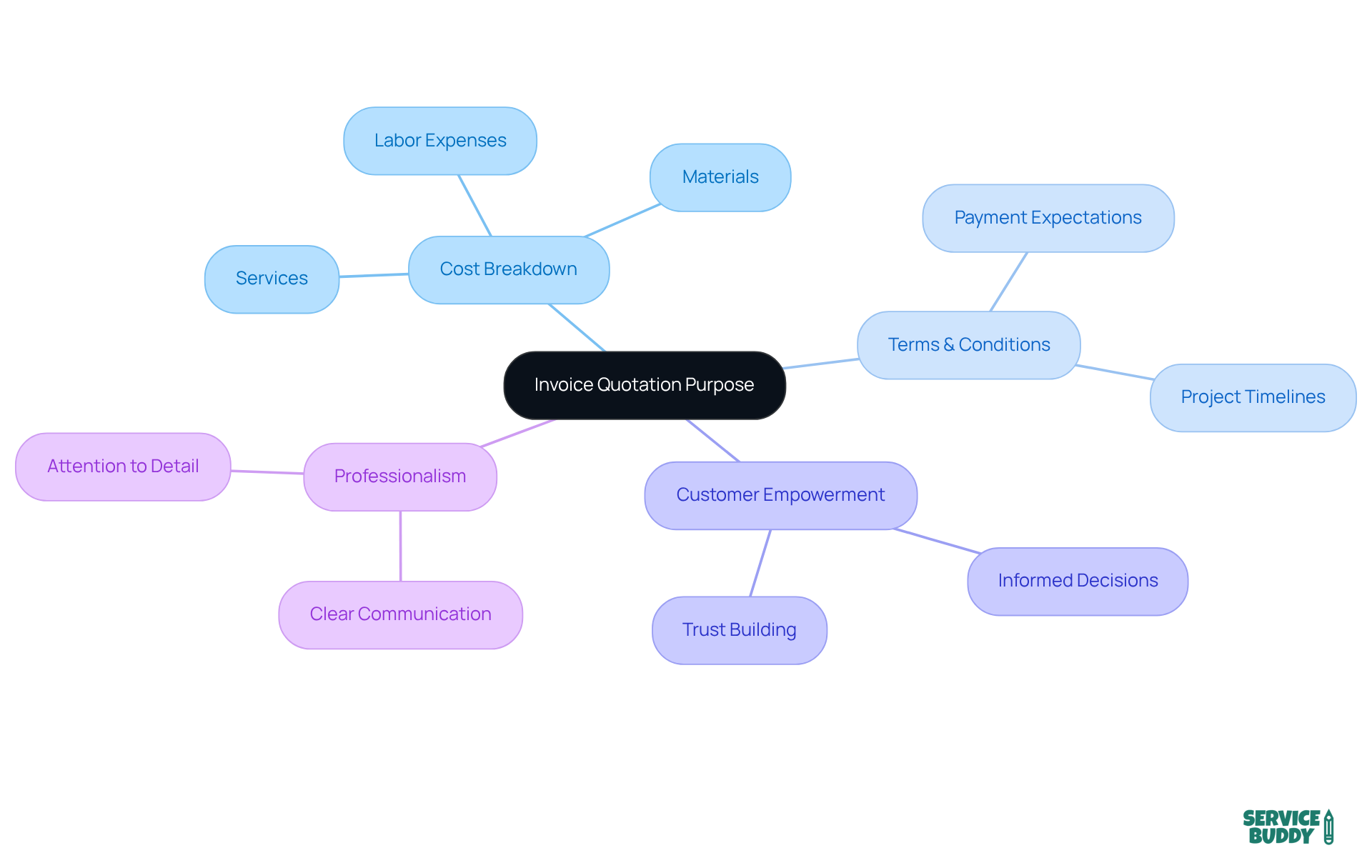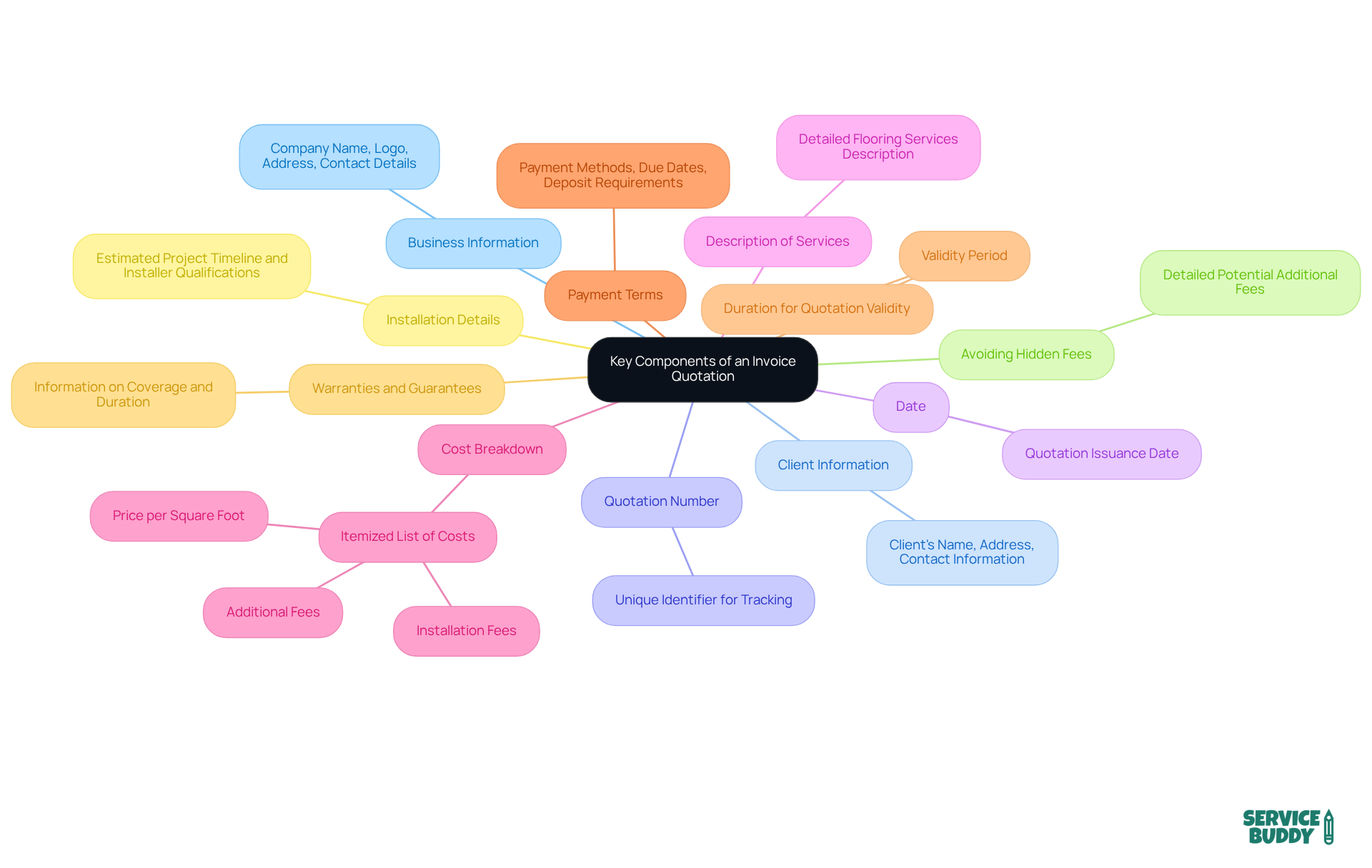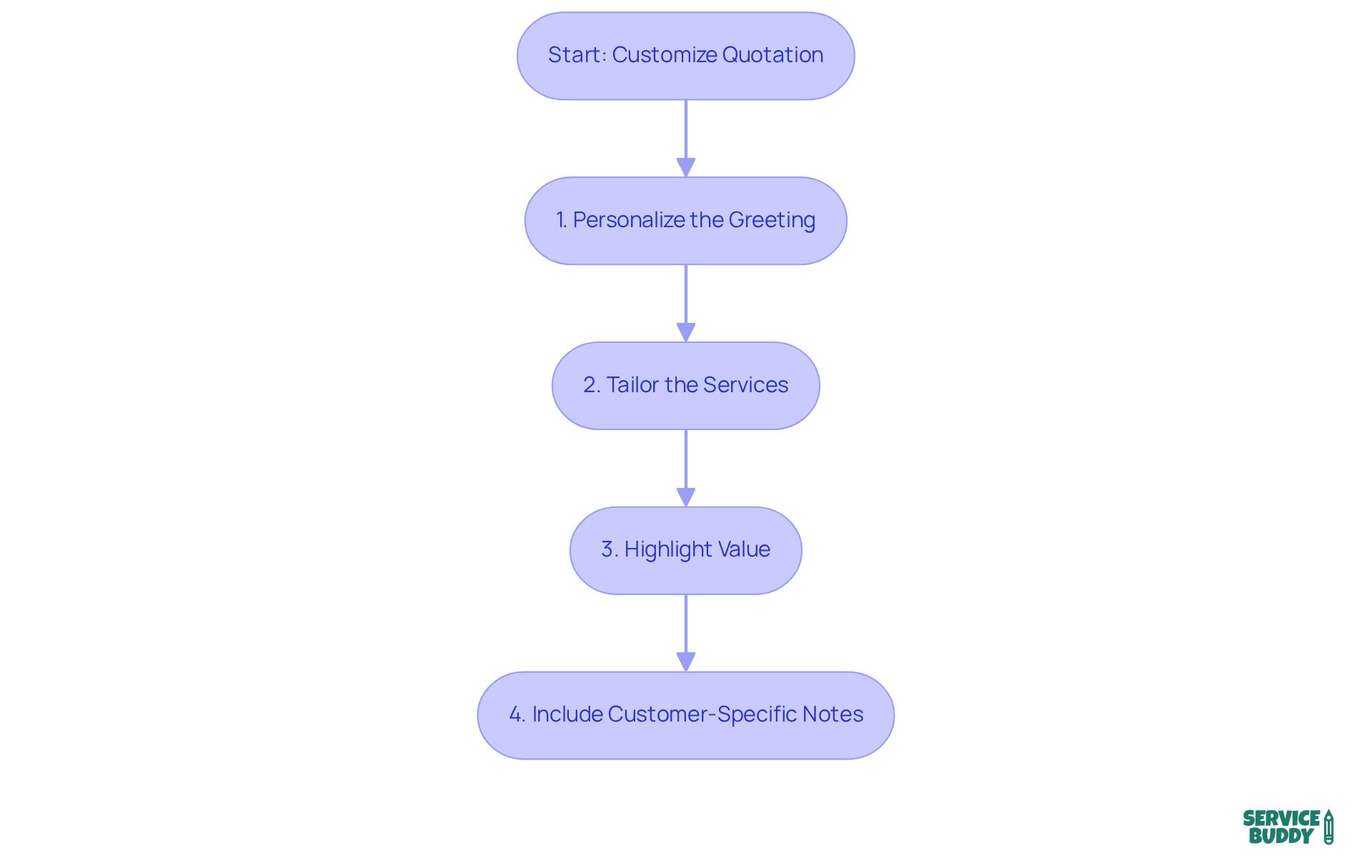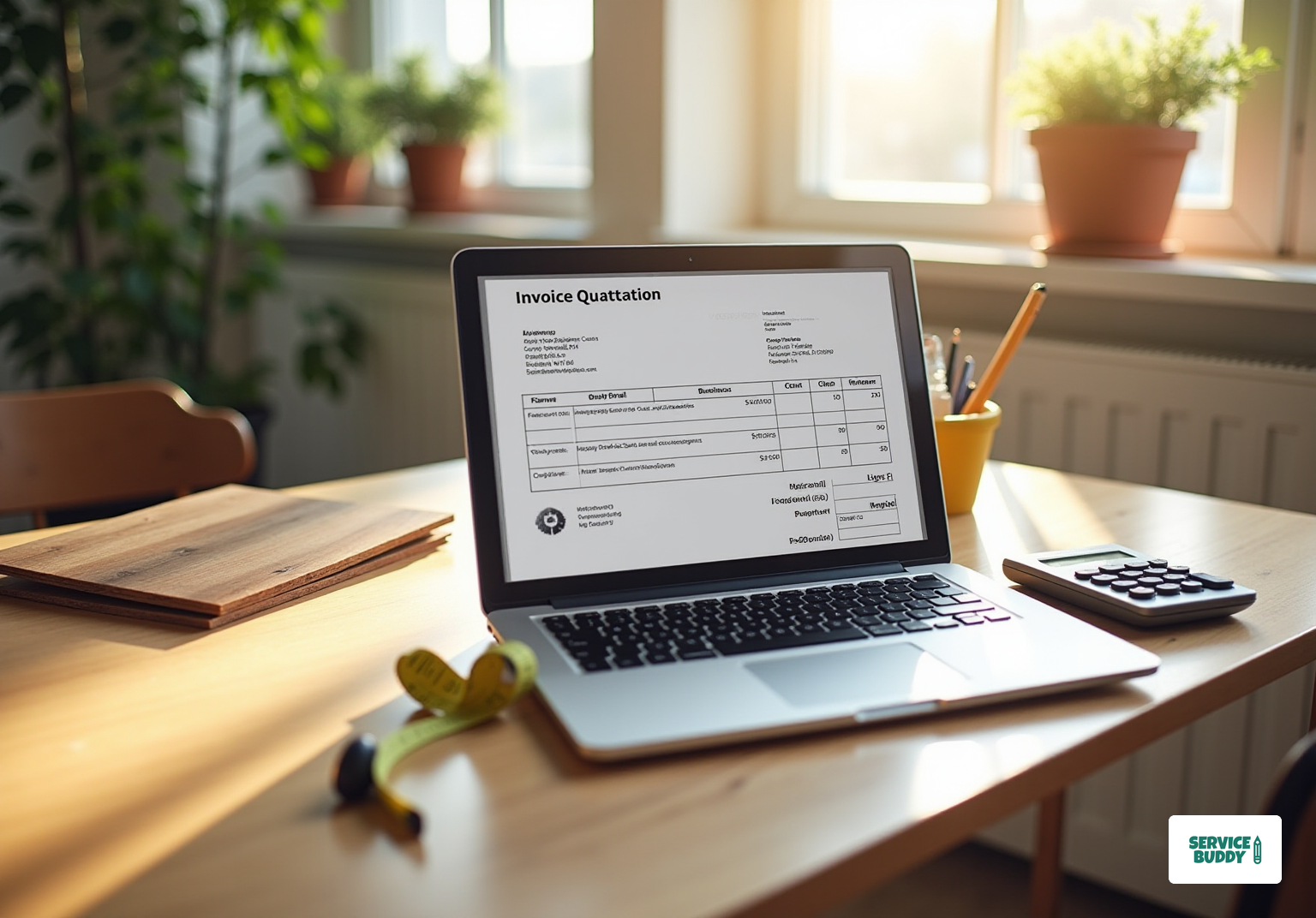5 Steps to Create an Effective Invoice Quotation for Flooring Businesses
Learn how to create an effective invoice quotation for your flooring business in five easy steps.

Introduction
Creating a detailed invoice quotation is a pivotal step for flooring businesses seeking to establish credibility and foster trust with clients. This essential document not only outlines costs but also clarifies project expectations, ensuring transparency and minimizing potential disputes. However, the challenge lies in crafting an effective quotation that resonates with clients while encapsulating all necessary details.
What key components transform a simple quote into a compelling proposal that secures business and enhances customer satisfaction?
Understand the Purpose of an Invoice Quotation
An invoice quotation serves as a formal proposal that outlines the expected costs for a flooring project before the work begins. It provides customers with an invoice quotation that includes a detailed breakdown of services, materials, and labor expenses, empowering them to make informed decisions. By explicitly stating the terms and conditions, including payment expectations and project timelines, organizations can avert misunderstandings and disputes down the line. This clarity not only but also positions the flooring business as professional and reliable in the eyes of the customer.

Identify Key Components of an Invoice Quotation
In the flooring industry, a well-structured invoice quotation is essential for maintaining clarity and professionalism. It should encompass several key components:
- Business Information: Include your company name, logo, address, and contact details to establish credibility.
- Client Information: Clearly state the client's name, address, and contact information for accurate communication.
- Quotation Number: Assign a unique identifier to facilitate tracking and reference.
- Date: Indicate the date the quotation is issued to provide context for validity.
- Description of Services: Offer detailed descriptions of the flooring services, specifying types of materials and labor involved to avoid misunderstandings.
- Cost Breakdown: Present an itemized list of costs, including price per square foot for materials, installation fees, and any additional fees such as delivery. This transparency assists customers in comprehending their investment and recognizing potential savings.
- Payment Terms: Clearly outline payment methods, due dates, and any deposit requirements to set expectations and facilitate timely payments.
- Validity Period: Indicate the length of time for which the estimate remains applicable, urging customers to make timely choices.
- Warranties and Guarantees: Include information on for both materials and workmanship to enhance trustworthiness.
- Installation Details: Mention the estimated project timeline and qualifications of the installers to instill confidence in the customer.
- Avoiding Hidden Fees: Clearly detail any potential additional fees, such as disposal or delivery, to avoid surprises in the final bill.
By concentrating on these elements, enterprises in the flooring industry can produce efficient invoice quotations that enhance client confidence and streamline the project commencement process.

Utilize a Professional Template for Your Quotation
Developing a refined and professional invoice quotation is crucial for businesses in the flooring industry. Utilizing a can significantly enhance this process. Many online platforms offer templates specifically tailored for flooring, ensuring all necessary components are included. Here are key steps to effectively use a professional template:
- Choose a Template: Select a template that embodies your brand's aesthetic and includes all essential elements, such as company information, unique invoice number, service descriptions, pricing details, and payment terms.
- Customize Your Template: Personalize the template by adding your company logo, adjusting colors, and modifying fonts to align with your branding. This not only enhances professionalism but also fosters brand recognition.
- Ensure Clarity: Maintain a clean and easy-to-read layout with clear headings and sections. A well-structured invoice estimate enhances communication and minimizes misunderstandings.
- Save as a PDF: After completing the quotation, save it as a PDF. This preserves the formatting and ensures that it is easily shareable with clients, facilitating prompt responses.
Statistics indicate that businesses utilizing invoice quotations can save considerable time—up to 50%—in producing professional documents, which allows them to focus more on core operations. Moreover, automated billing can help reduce administrative costs and improve cash flow management. By following these steps, flooring enterprises can create efficient invoice quotations that streamline their processes and enhance customer satisfaction and trust. As noted by Houzz Pro, "Sending a detailed invoice for your flooring job is crucial to the success of your business.

Customize the Quotation for Your Client
Customizing an invoice quotation is crucial for meeting customer expectations and improving satisfaction. Here’s how to effectively tailor your quotations:
- Personalize the Greeting: Start with a friendly salutation that includes the individual's name and a message that demonstrates your awareness of their particular needs or earlier discussions. This fosters a connection and shows that you value their business.
- Tailor the Services: Modify the services listed in the quotation to align with the client's unique requirements. Whether they favor certain types of surfaces or particular installation techniques, ensuring that your proposal reflects their preferences shows attentiveness and professionalism.
- Highlight Value: Clearly articulate the unique selling points of your services. This could include warranties, the quality of materials used, or your extensive expertise in the flooring industry. By emphasizing these aspects, you reinforce the value of your offering and justify the investment.
- Include Customer-Specific Notes: Incorporate notes that address any specific concerns or requests the customer raised during initial discussions. This not only shows that you listened but also helps in building trust and rapport.
Statistics indicate that personalized service estimates can significantly enhance customer satisfaction. For example, a study revealed that companies that customized their proposals experienced a 30% rise in project acceptance rates. Successful entrepreneurs often emphasize that customized proposals result in increased conversion rates, as customers feel more comprehended and appreciated. As Terry Holmes, a flooring specialist with over 30 years of experience, states, "When clients see that you’ve taken the time to customize their proposal, they’re more likely to trust you and choose your services." By adopting a client-focused strategy in your invoice quotation proposals, you can enhance your company's reputation and stimulate growth.

Review and Finalize Your Invoice Quotation
Before sending your invoice quotation, it is essential to meticulously review and finalize it. By adhering to the following steps, you can ensure precision and professionalism:
- Check for Accuracy: Scrutinize all figures, descriptions, and terms to eliminate any errors. Precise quotes significantly enhance customer satisfaction and lead to favorable reviews, ultimately fostering business growth.
- Proofread: Carefully examine the document for spelling and grammatical errors that could undermine your professionalism. A polished statement reflects your attention to detail and commitment to quality. Statistics indicate that documents with errors can lead to misunderstandings and damage credibility.
- Confirm Client Details: Verify that the client’s information is correct and current. This step is vital for maintaining trust and ensuring smooth communication throughout the project.
- Get Feedback: If feasible, have a colleague review the quotation to gain a fresh perspective. Collaborative input can help identify potential oversights and enhance the overall quality of the document.
- Specify : If relevant, ensure the manufacturer warranty is clearly outlined in the quote for the materials. This clarity ensures customers understand their coverage and reduces potential disputes.
- Highlight Hidden Costs: Confirm there are no hidden costs or fees in the flooring quote. Transparency in pricing promotes trust and satisfaction among customers.
- Emphasize Itemization: Clearly itemize costs, including the quantity of supplies needed and specific materials required for the project. This clarity assists customers in comprehending where their funds are directed.
- Legal Review: Consider having an attorney review the language used in your quotes to avoid making promises that cannot be fulfilled. This step can prevent potential legal issues.
- Send Promptly: Once completed, dispatch the estimate to the customer without delay, preferably within 24 hours of the initial request. Prompt replies showcase your professionalism and responsiveness, which are crucial for developing strong relationships with customers.
By following these steps, flooring businesses can enhance the accuracy of their invoice quotations, thereby fostering trust and satisfaction among clients.

Conclusion
Creating an effective invoice quotation is pivotal for flooring businesses aiming to establish trust and professionalism with their clients. This structured approach to crafting quotations not only details costs but also enhances customer relationships. By emphasizing clarity and customization, flooring businesses can present themselves as reliable and attentive to client needs—essential for securing projects and fostering long-term partnerships.
Key components of an effective invoice quotation include:
- Comprehensive business and client information
- A clear breakdown of services and costs
- Well-defined payment terms
Utilizing professional templates and personalizing the quotations enhances the proposal's effectiveness, demonstrating a commitment to customer satisfaction. Moreover, meticulous review and finalization of the document ensure accuracy and professionalism, reducing the likelihood of misunderstandings and disputes.
Ultimately, a well-crafted invoice quotation serves as more than just a financial document; it is a powerful tool for building trust and credibility in the flooring industry. By implementing the strategies discussed, flooring businesses can improve their quotation processes, leading to increased customer satisfaction and higher project acceptance rates. Embracing these practices not only streamlines operations but also positions businesses for growth and success in a competitive market.
Frequently Asked Questions
What is the purpose of an invoice quotation in a flooring project?
An invoice quotation serves as a formal proposal outlining the expected costs for a flooring project before work begins. It includes a detailed breakdown of services, materials, and labor expenses, helping customers make informed decisions and preventing misunderstandings.
What are the key components of an invoice quotation?
Key components include business information, client information, a unique quotation number, the date of issuance, a description of services, a cost breakdown, payment terms, validity period, warranties and guarantees, installation details, and information on avoiding hidden fees.
Why is it important to include business and client information in an invoice quotation?
Including business information establishes credibility, while client information ensures accurate communication, which is crucial for maintaining professionalism and clarity.
How should the cost breakdown be presented in an invoice quotation?
The cost breakdown should be itemized, listing costs such as price per square foot for materials, installation fees, and any additional fees like delivery. This transparency helps customers understand their investment and identify potential savings.
What should be outlined in the payment terms section of an invoice quotation?
The payment terms section should clearly outline payment methods, due dates, and any deposit requirements to set expectations and facilitate timely payments.
Why is it necessary to indicate the validity period of an invoice quotation?
Indicating the validity period informs customers how long the estimate remains applicable, encouraging them to make timely decisions.
How can warranties and guarantees enhance the trustworthiness of an invoice quotation?
Including information on warranties and guarantees for materials and workmanship enhances trustworthiness by assuring customers of the quality and reliability of the services offered.
What installation details should be mentioned in an invoice quotation?
Installation details should include the estimated project timeline and the qualifications of the installers to instill confidence in the customer regarding the execution of the project.
How can businesses avoid hidden fees in an invoice quotation?
Businesses can avoid hidden fees by clearly detailing any potential additional charges, such as disposal or delivery fees, to prevent surprises in the final bill.
List of Sources
- Understand the Purpose of an Invoice Quotation
- wagnermeters.com (https://wagnermeters.com/moisture-meters/wood-info/5-things-when-quoting-flooring-job)
- urable.com (https://urable.com/2025/04/10/elevate-your-business-with-professional-quotes-and-invoices)
- bookcleango.com (https://bookcleango.com/blog/flooring-industry-statistics)
- businessnewsdaily.com (https://businessnewsdaily.com/16026-quote-invoice-difference.html)
- fortunebusinessinsights.com (https://fortunebusinessinsights.com/flooring-market-102740)
- Identify Key Components of an Invoice Quotation
- reliabills.com (https://reliabills.com/blog/how-to-create-a-flooring-contractor-invoice)
- nextfloorsllc.com (https://nextfloorsllc.com/blog-post19)
- avalonflooring.com (https://avalonflooring.com/blogs/blog/commercial-flooring-costs)
- hewnfloor.com (https://hewnfloor.com/blogs/news/what-to-expect-when-getting-a-flooring-installation-estimate?srsltid=AfmBOorMd-2T0sVDVyNsIIqM6vpqUiTAFJYWhbGwvih5yB__3ua-y5Eu)
- marketsharp.com (https://marketsharp.com/blog/how-to-create-an-invoice-for-a-flooring-job-free-template-included)
- Utilize a Professional Template for Your Quotation
- reliabills.com (https://reliabills.com/blog/how-to-create-a-flooring-contractor-invoice)
- marketsharp.com (https://marketsharp.com/blog/how-to-create-an-invoice-for-a-flooring-job-free-template-included)
- houzz.com (https://houzz.com/pro-learn/blog/flooring-invoice-template-example)
- mooninvoice.com (https://mooninvoice.com/blog/benefits-of-invoice-template)
- Customize the Quotation for Your Client
- holmesflooring.com (https://holmesflooring.com/2022/12/03/wood-flooring-industry-statistics)
- fcnews.net (https://fcnews.net/2025/05/quote-that-how-a-remote-first-approach-is-modernizing-flooring-estimates)
- 97+ NEW Customization Statistics (2025) (https://customcy.com/blog/customization-stats)
- urbantasker.com (https://urbantasker.com/blog/how-to-write-present-free-quotes-to-home-renovation-clients-ideas-for-contractors)
- 50 Stats Showing The Power Of Personalization (https://forbes.com/sites/blakemorgan/2020/02/18/50-stats-showing-the-power-of-personalization)
- Review and Finalize Your Invoice Quotation
- houzz.com (https://houzz.com/pro-learn/blog/flooring-invoice-template-example)
- wagnermeters.com (https://wagnermeters.com/moisture-meters/wood-info/5-things-when-quoting-flooring-job)
- footprintsfloors.com (https://footprintsfloors.com/blog?post=new-virtual-estimates)
- americasfloorsource.com (https://americasfloorsource.com/a/blog/top-5-things-to-look-for-on-your-flooring-quote)
- humbertosflooring.com (https://humbertosflooring.com/blog/2023/4/20/strategies-for-a-successful-flooring-estimate)
See Service Buddy in action with a live demo
Everything you need to run your flooring business, Service Buddy is your all-in-one management platform.




.svg)
